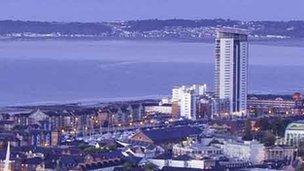Hammerson pulls out of £1bn Swansea retail project
- Published

The 29-storey Meridian Tower block on the seafront is thriving
The firm behind plans for a £1bn transformation of Swansea city centre has pulled out of the project.
Hammerson was appointed five years ago by the city's council to lead the regeneration.
But there have been concerns among council officials about the lack of progress despite the financial crisis.
The council is now carrying our a major review over the next step but Hammerson will continue to look after the Parc Tawe site which it owns.
"We've been working closely with Hammerson for some time but it's become clear their model for redeveloping the city centre has had to change due to the current economic climate and it no longer fits with our ambitions," said Nick Bradley, the council's cabinet member for regeneration.
"The traditional retail model isn't working so we need to find a different solution and the time is right for the council to work with other developers to achieve our ambition and deliver a model that works for Swansea."
A Hammerson spokesman added: "The decision not to renew the co-operation agreement with Swansea council is a mutual one but through our ownership and management of Parc Tawe we remain a significant investor in Swansea and we will continue to work with the council."
Hammerson, which is behind Birmingham's Bullring and Bristol's Cabot Circus, is due to submit a planning application for Parc Tawe which will include a new anchor tenant, new restaurants, an environmental upgrade and better pedestrian links with the city centre.
Swansea has struggled to find a way of successfully regenerating the centre following the collapse of the long-time proposed Castle Quays development in 2004 which suffered several false starts.
It also lost the David Evans department store with the resulting shopping centre built on the site taking time to be fully let, although the Salubrious Place project at the bottom of Wind Street has been successful.
The SA1 waterfront development on the east of the River Tawe and the 29-storey Meridian Tower block on the seafront are thriving, as are out-of-town complexes in Fforestfach and Morfa.
Independent traders
But what has added to Swansea's city centre retail problems is the opening of the £675m St David's shopping centre in Cardiff four years ago - where John Lewis is the anchor tenant - which attracted 36m visits in its first year alone.
The council has placed the focus on increasing footfall and attracting independent traders to the centre as opposed to trying to compete with Cardiff.
"We are looking for a fairly radical departure from the standard city centre development option," said council leader David Phillips.
"We want a Swansea solution that's suitable to the circumstances here and not what every other city has."
As well as attracting independent traders and niche businesses alongside big high street names, offices and housing are also included in the options.
Swansea Market is also receiving a £2m upgrade while the purchase and demolition of the St David's Shopping Centre and Oldway House sites has been completed ready for any future development.
The first phase of the £8m Boulevard Project to create a tree-lined city street between the River Tawe bridges and Princess Way in the city centre is due to be completed in November.
A two-day conference will be held in the new year to work out what the new approach could be and is set to attract national and international experts who will tackle issues such as on-line shopping and its impact on the high street.
Alongside the conference, a competition will also be held for architects and students to design a modern and welcoming city centre that combines retail, residential and office developments.
The council-led review will also revisit earlier plans for the city centre and look at what can be done in future to regenerate the city centre, create jobs and boost prosperity.
- Published26 June 2012
- Published7 December 2011
- Published31 July 2011
- Published17 June 2011
- Published26 July 2010